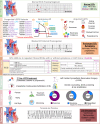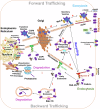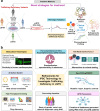Ion channel traffic jams: the significance of trafficking deficiency in long QT syndrome
- PMID: 39788950
- PMCID: PMC11717978
- DOI: 10.1038/s41421-024-00738-0
Ion channel traffic jams: the significance of trafficking deficiency in long QT syndrome
Abstract
A well-balanced ion channel trafficking machinery is paramount for the normal electromechanical function of the heart. Ion channel variants and many drugs can alter the cardiac action potential and lead to arrhythmias by interfering with mechanisms like ion channel synthesis, trafficking, gating, permeation, and recycling. A case in point is the Long QT syndrome (LQTS), a highly arrhythmogenic disease characterized by an abnormally prolonged QT interval on ECG produced by variants and drugs that interfere with the action potential. Disruption of ion channel trafficking is one of the main sources of LQTS. We review some molecular pathways and mechanisms involved in cardiac ion channel trafficking. We highlight the importance of channelosomes and other macromolecular complexes in helping to maintain normal cardiac electrical function, and the defects that prolong the QT interval as a consequence of variants or the effect of drugs. We examine the concept of "interactome mapping" and illustrate by example the multiple protein-protein interactions an ion channel may undergo throughout its lifetime. We also comment on how mapping the interactomes of the different cardiac ion channels may help advance research into LQTS and other cardiac diseases. Finally, we discuss how using human induced pluripotent stem cell technology to model ion channel trafficking and its defects may help accelerate drug discovery toward preventing life-threatening arrhythmias. Advancements in understanding ion channel trafficking and channelosome complexities are needed to find novel therapeutic targets, predict drug interactions, and enhance the overall management and treatment of LQTS patients.
© 2025. The Author(s).
Conflict of interest statement
Conflict of interest: The authors declare no competing interests.
Figures



Similar articles
-
Drug-induced Inhibition and Trafficking Disruption of ion Channels: Pathogenesis of QT Abnormalities and Drug-induced Fatal Arrhythmias.Curr Cardiol Rev. 2016;12(2):141-54. doi: 10.2174/1573403x12666160301120217. Curr Cardiol Rev. 2016. PMID: 26926294 Free PMC article. Review.
-
The proteostasis interactomes of trafficking-deficient variants of the voltage-gated potassium channel KV11.1 associated with long QT syndrome.J Biol Chem. 2024 Jul;300(7):107465. doi: 10.1016/j.jbc.2024.107465. Epub 2024 Jun 12. J Biol Chem. 2024. PMID: 38876300 Free PMC article.
-
PUFA stabilizes a conductive state of the selectivity filter in IKs channels.Elife. 2024 Oct 31;13:RP95852. doi: 10.7554/eLife.95852. Elife. 2024. PMID: 39480699 Free PMC article.
-
Kir2.1-NaV1.5 channelosome and its role in arrhythmias in inheritable cardiac diseases.Heart Rhythm. 2024 May;21(5):630-646. doi: 10.1016/j.hrthm.2024.01.017. Epub 2024 Jan 18. Heart Rhythm. 2024. PMID: 38244712 Review.
-
Prediction of Kv11.1 potassium channel PAS-domain variants trafficking via machine learning.J Mol Cell Cardiol. 2023 Jul;180:69-83. doi: 10.1016/j.yjmcc.2023.05.002. Epub 2023 May 13. J Mol Cell Cardiol. 2023. PMID: 37187232
Cited by
-
Multi-omics analysis of two rat models reveals potential role of vesicle transport and autophagy in right ventricular remodeling.Sci Rep. 2025 Apr 18;15(1):13401. doi: 10.1038/s41598-025-98347-8. Sci Rep. 2025. PMID: 40251385 Free PMC article.
References
-
- Krahn, A. D. et al. Congenital long QT syndrome. JACC Clin. Electrophysiol.8, 687–706 (2022). - PubMed
-
- Cohagan, B. & Brandis, D. Torsade de Pointes. In StatPearls [Internet]. Treasure Island (FL): StatPearls Publishing, (2023).
-
- Jervell, A. & Lange-Nielsen, F. Congenital deaf-mutism, functional heart disease with prolongation of the Q-T interval, and sudden death. Am. Heart J.54, 59–68 (1957). - PubMed
-
- Schwartz, P. J. et al. The Jervell and Lange-Nielsen syndrome: natural history, molecular basis, and clinical outcome. Circulation113, 783–790 (2006). - PubMed
Publication types
Grants and funding
LinkOut - more resources
Full Text Sources

